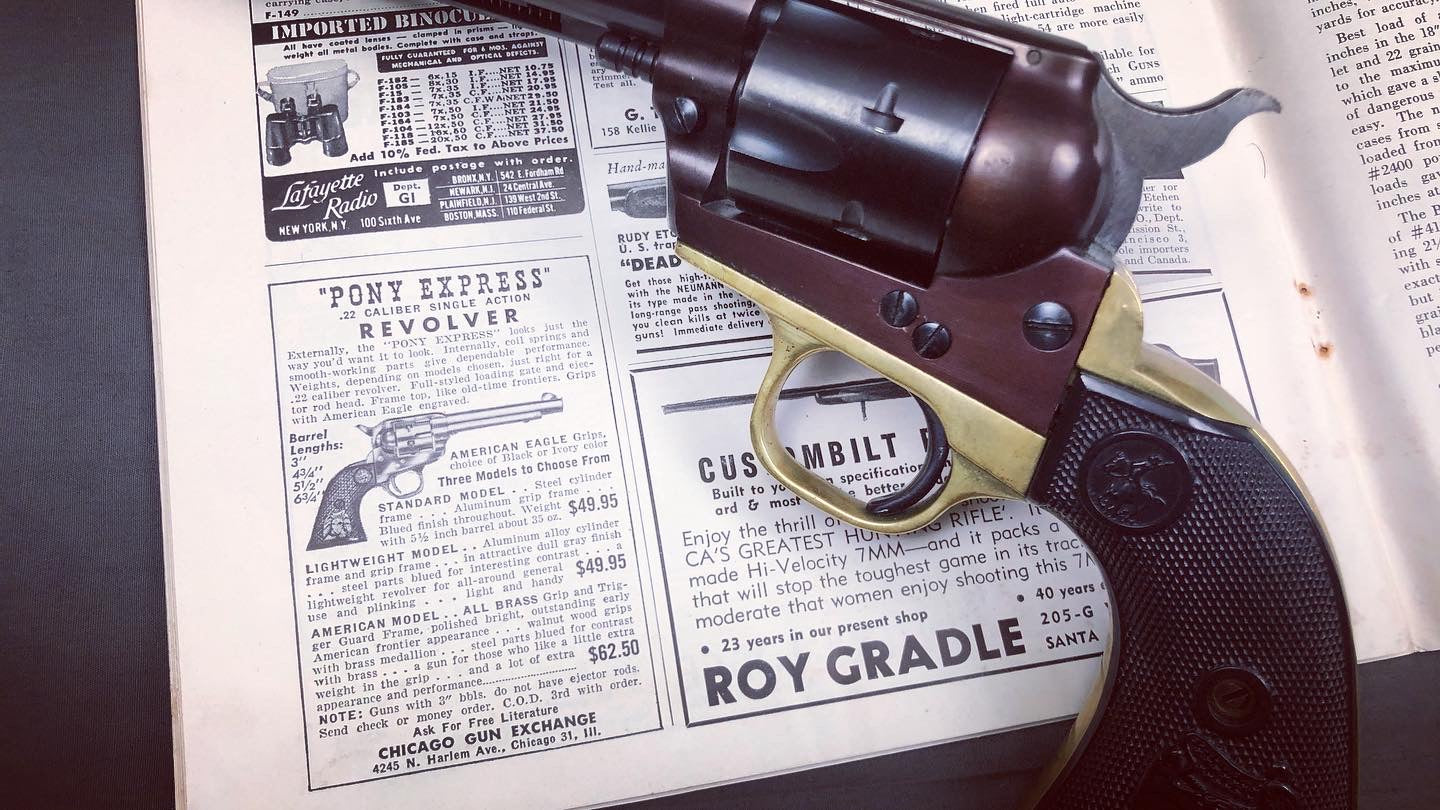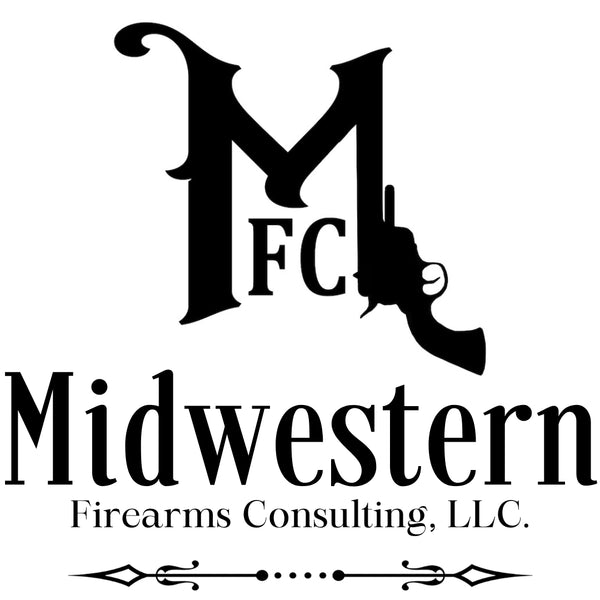The "Pony Express" Revolver


The first commercially produced firearm by Erl Svendsen in his Chicago location, the "Pony Express" is a six shot, single action revolver that appears to be a mixture of a 1/2 scaled Colt SAA (or possibly a Frontier Scout) and the Ruger Single Six.
It's important to remember that 1960-'61 was the 'centennial' of the Pony Express riders (1860-1960). We know that Colt also made a "Pony Express" model to coincide with the centennial as well. Shown here is an original print ad advertising a limited run of 1,000 commemorative models.

Perhaps Mr. Svendsen wanted to produce these as a tribute to that 100 year anniversary. The above print ad is from a 1961 magazine printing.
We know that Mr. Svendsen had advertised his version of the Pony Express as early as 1955. The print ads below are from GUNS magazine, 1955.


There were three models of Erl Svendsen's "Pony Express".

The "A" models (or 'model A').

First produced in the 1950's. [UPDATING]
They have no letter prefix for the serial number as seen here:


The A models were in caliber .22LR and have a very distinctive 'reddish' or plum color to the frame, most likely a result of chemical mixture in the bluing process. Examples of this are seen in the photos above.
Here we see "PONY EXPRESS" marked on the right side of the frame under the cylinder.

Directly behind this mark is the logo of the pony express rider that also appears on the upper portion of the black grip panels. This was only done on the A models. No circled rider logo as been seen on B or C models.

Serial Numbers
Serial numbers were applied to the underside of the frame (where the trigger guard meets the frame in front of the trigger) and to the ratchet side of the cylinder. The "A" models used the last digit of the serial number for marking and Identification as seen here:

Triggers
"A" models had slightly curved and the blocky-style trigger just like the Colt F.S. and the very early Rugger S.S. models.


*Original sales records indicate that 219 of the A model revolvers were produced. That being said, there are a number of examples that have been observed outside the 219 documented on sales receipts.
The "B" models (or 'model B').



The second, "B" models will all have a letter B in front of the serial number and were in caliber .22 LR. The B models all have a larger front sight and a thicker receiver strap. The "B" models are also easily distinguishable by their frame color which is more of a traditional 'blue' than the previous "A" models.
Serial numbers
Same as the "A" models, the serial number is stamped into the underside of the frame where the trigger guard attaches. Differing from the previous models, the full SN is applied to the "B" model cylinders as seen here on example B 547:

Triggers


A more drastic curve and smoother, round edges are similar to that of the
Schmidt-Rubin designed rifles and carbines.
*Original sales records indicate that there were 198 documented "B" model revolvers produced, although again many have been observed outside of those officially documented.
The "C" models (or 'model C').



The 3rd variation had a C prefix before the serial number and were manufactured in caliber .38 special. The rest of the revolver is similar to the B model with the larger front sight and blued frame.
Serial Numbers
Unlike the "A" and "B" models, the "C" models have no SN applied to the cylinder. The SN is applied to the underside of the frame just as the previous models, now with the addition of the 'C' denoting the model number.
Note how the "C" model cylinders have a nicely recessed chambers so when inserted, the cartridge sits flush with the rest of the cylinder as seen here:

*Original sales records indicate that 27 of the "C" models were produced and sold officially, but as with the other models, there have been examples outside of these official numbers observed in the hands of collectors.
Post "A" model changes (the "B" and "C" models)
Sights
The "A" models had a very low front sight and thin top receiver strap.


Top Strap
The top strap of the receiver was strengthened by adding at least .10", almost doubling the original size.


Bronze casting

Ejector rod housing
The Ejector rod housing was simplified for the "B" models and continued through the rest of his production.

Trigger

Markings
Two barrel markings showing a Chicago location have been verified. This name change is also the first of multiple, company name changes. The "Pony Express" revolvers were only manufactured at the Chicago locations.

The C models have the same stamp as the B models. [UPDATING]
Serial numbers
The addition of the letter "B" to the frame SN. The "B" models now have the full serial number stamped into the cylinder as well.

It's important to note that the serial numbers were NOT consecutive.
Post-"B" model changes
Several changes were needed to accommodate the .38 spl cartridge for use in the "C" models.
Cylinder length



Frame modifications
One of the changes that needed to be addressed is conversion from rimfire, for the .22 LR, to centerfire for the .38 special cartridge. Utilizing the same transfer bar system, the firing pin hole or transfer bar needed to be lowered to make contact with a centerfire cartridge as evident by the cartridge outlines in this photo:


Forcing Cone
The cylinder cut in the frame appears to be very similar (if not the same) but we can see the shortening of the forcing cone on the "C" model that allows the lengthened cylinder of the .38 spl to be installed.

Serial numbers
The addition of the letter "C" to the frame SN. The "C" models no longer have the SN applied to the cylinder.
It's important to note that the serial numbers were NOT consecutive.
Cylinder Measurements
OAL = Overall Length. OAW = Overall Width. CP = Cylinder Pin (base pin)

And finally, let's take a closer look at one of the beautiful grip panels that came standard.
Boxes
|
|
 |
*Note the copyright date of 1957
Variations
Although most of the models produced had traditional bluing, brass backstrap and trigger guard with the signature black plastic grips, they were offered in a variety of barrel lengths, grip options, and finishes.
Let's take a look at a few examples.
Barrel lengths
A variety of barrel lengths were offered with the most common lengths being 5 1/2" & 6 3/4. Records also indicate a 3 1/2" 'sheriff's model', 4 1/2", 9 1/2" and 12" buntline.



*Thanks to SP for allowing the use of this photo. For his custom made stag grips click HERE.
Grip options
There are a few documented grip variations including wood, stag, and "pearl" in addition to the standard black plastic, American Eagle grips.
Shown here is a B model with a 2 piece, wooden grip option. Wood appears to be American walnut.
 *Thanks to a private collector for allowing the use of these photos.
*Thanks to a private collector for allowing the use of these photos.
Here is an example of the beautiful stage grips on a 6 3/4" A model.

Finishes
According to official sales records, a few revolvers left the shop with factor finishes on the receiver other than the traditional bluing.

There are notes indicating a "Black Nickel" finish as well.

Other oddities
Standard Pony Express + a timed, fit, and matching numbered .22 magnum cylinder.

Collector Stories:
The Man Behind the Gun

This chrome "A" model was purchased Mr. Greenwald from Erl's shop somewhere in the 1950's or early 60's. It is not known for certain if this finish was done in Svendsen's shop or after purchasing as Mr. Greenwald was also a gunsmith and later owner of the Foothills Shooting Center in Lakewood, CO.

Mr. Greenwald, seen here at far right, was also an active member of the Bell's Frontier Club, a local quick draw shooting club in the 1950s-1960s.
Mr. Greenwald's son Peter was kind enough to share this information with us and allow the use of these photos. Thank you Peter!
Honorable Mentions

Page 22 from
"Great Western Arms Company: Revolvers and Derringers Manufactured from 1954-1964." by John C. Dougan and Jim Hoobler. Available HERE or HERE.

Page 166 from
"Saga of the Colt Six-Shooter: and the men who used it..." by George E. Virgines. Available HERE.
"Wings of a Century: Romance of Transportation." A Century of Progress, International Exposition 1833-1934.

Erl Svendsen participated as a cast member from the 'Century of Progress' exposition in Chicago of 1934. We see his name listed on the cast sheet, although both names were misspelled.


"Interlude Three: The Gold Rush" had a section dedicated to the Pony Express. Is this the portion of the show he participated in or perhaps inspiration for what was to come?





Have an example you'd like to share?
Reach out and we would love to feature it here for other collectors to enjoy.



